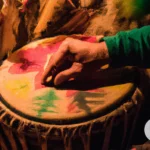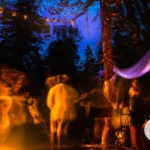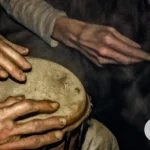The ancient Greeks were a civilization steeped in mythology, where the gods and their interactions with mortals were a central part of their belief system. However, few people realize the extent to which shamanic practices also played a role in their culture. Shamanism is an ancient practice that involves contacting the spirit world through techniques like drumming, chanting, and the use of psychoactive substances. While many cultures around the world have a history of shamanism, the influence of these practices in Greek mythology is often overlooked. In this article, we will explore the fascinating role of shamanism in ancient Greek myths and examine how it shaped their worldview.
The Ancient Greek Worldview and Shamanism

Shamanism, as an animistic practice that engages with the spirit world, has played a significant role in many ancient cultures. Greek mythology, with its vibrant and complex pantheon of gods and goddesses, is no exception. The ancient Greeks believed that their world was inhabited by a multitude of supernatural beings that influenced their daily lives. Similarly, shamanism is rooted in the belief that the spirit world is constantly interacting with the physical world, and that shamans can communicate with spirits to influence the course of events in their communities. It is not surprising, then, that shamanic practices have been found throughout Greek mythology. From the pantheon of gods, such as Hermes and Hecate, to the shamanic rituals performed in the stories of heroes like Perseus and Hercules, shamanism was intimately tied to the ancient Greek worldview.
Shamanism and the Greek Pantheon
In the ancient Greek worldview, shamanism played a significant role in their religious beliefs. Greek gods and goddesses had their own distinct personalities, characteristics, and powers, which made them unique in their own way.
The Greek pantheon had a number of deities that were associated with shamanism. The god Apollo was considered a god of healing and prophecy. He was often depicted with a bow and arrow, and his temples were sites of oracles where people could go to receive divine guidance and healing. The goddess Athena was a goddess of wisdom, who was often associated with medicine and the healing arts. The god Dionysus was considered the god of wine and ecstasy, and his cult involved ecstatic experiences that were similar to shamanic practices.
Another Greek deity associated with shamanism was the god Hermes. He was the messenger of the gods and was often depicted as a trickster. Hermes was also known for his association with thieves and travelers. His role as a shaman was related to his ability to travel between the world of the gods and the world of mortal men. He was often called upon to guide souls to Hades, the underworld.
The goddess Hecate was another important deity in Greek shamanism. She was associated with magic and witchcraft and was believed to be able to see the future. Her role in shamanism was related to her association with the moon, which was considered to be a powerful symbol of the subconscious mind. Hecate was often called upon to help people enter into altered states of consciousness, such as during rituals or rites of passage.
It is important to note that while Greek mythology had its own unique pantheon of deities, shamanism was not limited to the Greek gods and goddesses alone. Many of the themes and practices associated with shamanism were also present in other cultures and religions around the world. For example, animal spirits played a significant role in Native American shamanic traditions, while Norse mythology incorporated elements of shamanism in its tales of the gods and goddesses. Shamanistic elements can also be found in Korean shamanism folklore or in the fascinating myths of Australian Aboriginal shamanism.
Shamanic Rituals in Greek Mythology
Shamanic rituals were an integral part of ancient Greek mythology. The Greeks believed that shamanic rituals had the power to connect them with the spirit world. These rituals were often conducted in caves, forests, or on mountaintops, and were used to seek guidance and healing from the gods.
One of the most well-known shamanic rituals in Greek mythology is the Eleusinian Mysteries. These were secret rituals that were held in honor of Demeter and Persephone, the goddesses of the harvest and fertility. The rituals were attended by both men and women and were believed to grant the participants knowledge of the afterlife.
Another important shamanic ritual in ancient Greek mythology was the Thesmophoria, which was a festival in honor of Demeter. During the festival, women would gather together and perform sacred rites, including the planting of seeds and the sacrifice of pigs. The festival was believed to ensure fertility and a good harvest.
In addition to these well-known rituals, there were also many smaller shamanic practices that were used by the Greeks. These included the use of divination tools such as bones, stones, and shells, and the practice of dream interpretation. The Greeks also believed in the power of music and dance to connect with the spirit world.
Shamanic rituals played an important role in ancient Greek mythology. They were used to seek guidance and healing from the gods, and were believed to have the power to connect the living with the spirit world. These rituals offer a fascinating insight into the beliefs and practices of the ancient Greeks, and their enduring fascination with the mysteries of the universe.
Read about animal spirits in Native American shamanic legends
Shamanic Deities in Greek Mythology
Shamanic deities played a significant role in Greek mythology. These gods and goddesses were believed to possess supernatural powers and were often called upon to aid in shamanic rituals. It was believed that Hermes and Hecate were the patron saints of these shamans. Hermes was considered the messenger of the gods and was associated with shamanic journeying, while Hecate was the goddess of witchcraft and magic. Another prominent shamanic deity was the centaur, who was seen as the guardian of the wilderness and the protector of the shaman. It is fascinating to see how shamanic elements are embedded in Greek mythology, just like in Norse, Korean and Australian Aboriginal shamanism.
Hermes and Hecate: The Patron Saints of Ancient Greek Shamans
Hermes and Hecate were considered the patron saints of shamanism in ancient Greek mythology. Hermes, the messenger of the gods, was also considered the god of magic, alchemy, and divination. He possessed immense knowledge of the underworld and was believed to be the guide of souls. He was associated with the practice of shamanism due to his ability to navigate between different realms.
Hecate, on the other hand, was a goddess of the moon, magic, and witchcraft. She was known for guiding individuals through the darkness of the night and was believed to have the power to banish evil spirits. Hecate was revered as a protector of shamans and witches and was considered the goddess of crossroads, which symbolized the intersection between different realities.
Together, Hermes and Hecate embodied the essence of shamanism in ancient Greek culture. They were revered as the teachers and protectors of shamans and provided the tools for individuals to navigate different realms of existence.
Their influence extended beyond ancient Greece and was evident in other cultures as well. In Norse mythology, Odin, the father of all gods, was also considered the god of magic, wisdom, and shamanism. In Korean shamanism, the goddess of nature, Chumong, was revered as a protector of the shaman and as a guide to the underworld. In Australian Aboriginal shamanism, the rainbow serpent was believed to be the creator of the universe and was a powerful symbol of shamanic energy.
Shamanism was an integral part of ancient Greek mythology, and Hermes and Hecate played a significant role in shaping this worldview. Their influence was felt not only in ancient Greek culture but also in other cultures around the world, where shamanism played a crucial role in the development of human consciousness and spirituality.
The Centaur: The Shamanic Guardian of the Wilderness
In Ancient Greek mythology, centaurs were known as the half-human, half-horse creatures who were the guardians of the wilderness. They were also associated with shamanism due to their ability to traverse the natural world effortlessly and communicate with nature spirits. They held an important role in Greek mythology due to their connection to the natural world and the spiritual realm.
The centaur was often depicted as a wild, untamed creature that was difficult to control. However, some centaurs were known to be wise and knowledgeable in shamanic practices. One such centaur was Chiron, who was known for his wisdom in medicine and shamanic practices. Chiron taught many of the Greek heroes how to use plants and natural remedies to heal themselves and others.
Centaurs were also known for their fierce protection of the natural world from human interference. They were seen as the guardians of the forests, rivers, and mountains. According to Greek mythology, centaurs were created by the god Apollo to protect the sacred groves and shrines in the wilderness.
Their connection to shamanism lies in their ability to communicate with the spirits of nature and the spiritual realm. They were seen as mediators between the natural world and the divine. Their shamanic practices involved drumming, chanting, and the use of trance states to communicate with the spiritual realm.
The centaur played an important role in Greek mythology as the shamanic guardian of the wilderness. Their ability to communicate with nature spirits and their fierce protection of the natural world made them an integral part of Ancient Greek culture. Chiron and other centaurs were revered for their knowledge of shamanic practices and their ability to heal. Their connection to shamanism highlights the importance of the natural world and the spiritual realm in Ancient Greek culture and mythology.
Shamanism in Greek Heroic Myths
Shamanism played a significant role in Greek heroic myths, where **shamanic characters** acted as intermediaries between the divine world and humanity. **Perseus** is considered the quintessential shamanic hero, known for his journey to kill Medusa and bring back her head. He received shamanic gifts that included a helmet of invisibility, which allowed him to enter and leave the underworld unnoticed, and winged sandals that enabled him to fly. Another well-known shamanic hero is **Orpheus**, who journeyed to the underworld to retrieve his wife but ultimately failed in his quest. Hercules offers another example of a shamanic hero who underwent trial and initiation, including the twelve
Subscribe to Our Newsletter
Sign up to receive the latest news and updates.
Perseus: The Shamanic Hero
Perseus is a well-known figure in Greek mythology, renowned for his bravery and heroic deeds. However, his story is also highly symbolic of the shamanic journey. Like a shaman, Perseus had to venture into the unknown, face his fears, and overcome obstacles in order to attain transcendence.
One of Perseus’ most famous feats was the slaying of the Gorgon Medusa, whose gaze could turn people to stone. Before embarking on this quest, Perseus received aid from the gods, including Athena and Hermes. Athena gifted Perseus with a polished shield, which allowed him to view Medusa’s reflection rather than looking directly at her. In this way, he was able to avoid her deadly gaze. Hermes gave Perseus a sword, which he used to decapitate Medusa.
Perseus’ encounter with Medusa is highly symbolic of the shamanic journey. The Gorgon is a representation of the unconscious mind, and her ability to turn people to stone is a metaphor for the power of fear to paralyze the psyche. Perseus’ polished shield represents his ability to reflect on himself and his own fears, rather than becoming paralyzed by them. His sword represents his willpower and his ability to cut through the illusions of his own psyche in order to overcome his fears and achieve enlightenment.
In addition to his encounter with Medusa, Perseus also had to navigate through a labyrinth in order to rescue Andromeda. His journey through the labyrinth is symbolic of the shamanic journey through the inner psyche, where the hero must confront his own darkness and overcome obstacles in order to achieve growth and transformation.
Perseus’ story is just one example of the numerous ways in which shamanic themes are present in Greek mythology. By exploring these themes, we can gain a greater understanding of the role that shamanism played in the ancient world, and how it continues to influence our own myths and legends today.
Internal link: If you want to learn more about shamanic themes in mythology, read our article about Korean Shamanism and Folklore.
Orpheus: The Shamanic Journey to the Underworld
Orpheus was a legendary musician and poet in Greek mythology who went on a shamanic journey to the underworld to bring back his deceased wife, Eurydice. Orpheus used his music to charm and negotiate with the deities of the underworld, including Hades and Persephone. During his journey, Orpheus had to pass through several obstacles, including the river of forgetfulness and the three-headed dog, Cerberus.
According to Greek mythology, Orpheus was able to charm even the stones and trees with his music, making them move and dance. This ability to communicate with nature and the spiritual realm is a characteristic of shamanism found in many cultures. In the case of Orpheus, his musical talent served as a tool for his shamanic journey, allowing him to connect with the spirits of the underworld and negotiate with them.
Orpheus’ journey to the underworld can be interpreted as a shamanic initiatory experience. In shamanism, initiatory experiences often involve a symbolic death and rebirth, where the shaman undergoes a profound transformation. Orpheus went through a similar process when he descended to the underworld and confronted death, returning to the world of the living with new knowledge and insight.
The story of Orpheus and his shamanic journey to the underworld shows the close relationship between shamanism and Greek mythology. It also illustrates how shamanic elements, such as communication with spirits and initiatory experiences, can be found in many different cultures and traditions. To learn more about shamanic elements in various mythologies, you can check out articles on /shamanic-elements-norse-myth/ and /fascinating-myths-australian-aboriginal-shamanism/.
Hercules: The Shamanic Initiation
One of the most well-known figures of Greek mythology, **Hercules** (or **Heracles** in Greek), underwent a shamanic initiation in order to become a hero. As a demigod, Hercules was partly human and partly divine, which gave him a unique ability to travel between the realms of the living and the dead. Hercules is said to have descended into the underworld in order to capture the three-headed dog Cerberus, and during this journey, he underwent a series of trials that tested both his physical and spiritual strength.
One interpretation of Hercules’ journey to the underworld is that it represents a shamanic initiation. Like many shamanic initiates, Hercules faced death and rebirth during his journey.**[1]** He was stripped of his mortal identity and forced to confront his own limitations and fears. Yet, by facing these challenges head-on, Hercules emerged from the underworld stronger and more powerful than ever before.
In many ways, Hercules embodies the archetype of the shamanic hero. He is a fearless warrior who is willing to go to great lengths to achieve his goals. But he is also a deeply spiritual figure who understands the importance of transcending his own ego in order to connect with the divine. Through his trials and tribulations, Hercules symbolizes the journey that all shamanic initiates must undertake in order to access the hidden wisdom of the spirit world.
The shamanic initiation of Hercules is an important aspect of Greek mythology that sheds light on the role of shamanism in ancient Greek culture. Hercules’ journey to the underworld represents the archetypal shamanic initiation – a journey of death and rebirth that requires the initiate to confront their own limitations and fears in order to access the hidden realms of the spirit world. By studying this myth, we can gain a deeper understanding of the transformative power of shamanic practices and the role they played in ancient Greek society.
**[1]:** Eliade, Mircea, and Willard R. Trask. *Shamanism: Archaic Techniques of Ecstasy*. Princeton University Press, 1972.
Conclusion
As we explored in this article, shamanism played a significant role in ancient Greek mythology. Through shamanic rituals and practices, the Greeks sought to connect with the spiritual realm and gain insights and knowledge to guide them through life.
The Greek pantheon was not immune to the influence of shamanism, with gods like Hermes and Hecate serving as patrons of ancient Greek shamans. The Centaur, a creature that embodied the natural world, was also considered a shamanic guardian of the wilderness.
In Greek heroic myths, we see the shamanic hero archetype embodied by individuals like Perseus, who defeated monsters and faced inner demons on his journey toward self-discovery. Orpheus used shamanic practices to journey to the underworld in search of his lost love, and Hercules underwent a shamanic initiation as part of his path to becoming a hero.
Overall, the role of shamanism in ancient Greek myths sheds light on the cultural and spiritual beliefs of this ancient civilization. Through the practices of shamanism, the Greeks sought to navigate the complexities of the natural world and the human condition. As with many ancient traditions, the legacy of shamanism in ancient Greece remains a source of fascination and inspiration for those seeking to connect with the spiritual world today.
Frequently Asked Questions
What is shamanism?
Shamanism is a spiritual practice that involves working with spirits and ancestors to achieve healing and guidance.
What is the Greek pantheon?
The Greek pantheon is the collection of gods and goddesses worshipped by the ancient Greeks.
How did shamanism play a role in Greek mythology?
Many Greek myths feature shamanic rituals, deities, and heroes who embark on shamanic journeys or receive shamanic initiations.
Who were Hermes and Hecate?
Hermes and Hecate were two of the primary deities associated with shamanism in ancient Greece. Hermes was the god of transitions and boundaries, while Hecate was the goddess of witchcraft and magic.
What is a centaur?
A centaur is a mythical creature with the upper body of a human and the lower body of a horse.
Why were centaurs significant in Greek mythology?
Centaurs were often depicted as guardians of the wilderness and were associated with shamanic practices. They were also notorious for their wild and unpredictable behavior.
Who was Perseus?
Perseus was a legendary hero in Greek mythology who is best known for slaying the Gorgon Medusa.
Who was Orpheus?
Orpheus was a legendary musician and poet in Greek mythology who famously journeyed to the underworld to rescue his beloved wife Eurydice.
Who was Hercules?
Hercules was a demi-god and hero in Greek mythology who was renowned for his strength and courage. He also underwent a shamanic initiation as part of his twelve labors.
What can we learn from exploring the role of shamanism in ancient Greek myths?
Studying the role of shamanism in Greek mythology can reveal a deeper understanding of the spiritual practices and beliefs of ancient cultures, as well as shed light on universal human experiences of healing, transformation, and transcendence.










